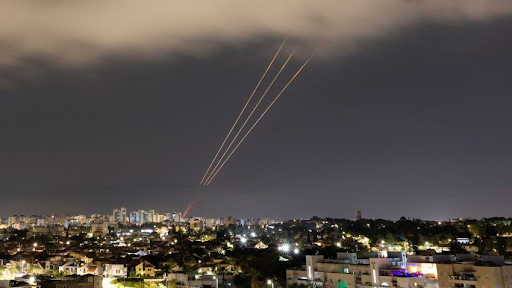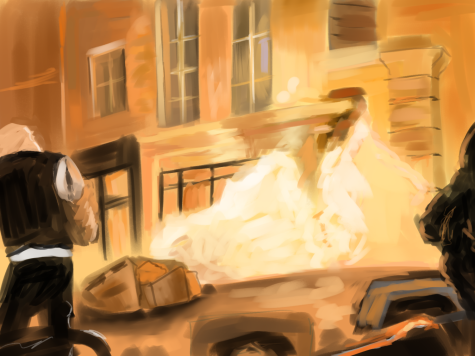What The War in Ukraine has Taught Us about Modern Warfare
January 20, 2023
While wars in Afghanistan, Myanmar, and Yemen have shown the brutal and chaotic nature of war in the modern era, the Ukrainian conflict is an entirely different scale of warfare. The Russia and Ukraine war has been the only full-fledged near peer conflict, consisting of two modern military countries that are almost evenly matched. This near peer conflict has shown a possible reality of warfare and is providing a treasure trove of lessons for the 21st century.
When Russia first invaded Ukraine on February 24th, 2022, it was expected that the much larger and well-equipped Russian army would quickly smash any opposition by the Ukrainian forces. This was the case for the first couple of days, as the Russian army swept in from 4 fronts and marched 100s of miles into Ukrainian land[1]. At the time, Most Western military analysts predicted that the Ukrainian capital of Kiev would fall within weeks if not days.
These predictions have turned out to be false, as the Russian invasion has stalled and Ukraine has quickly taken back territory in devastating counterattacks as the months roll on. There are unique reasons that the Ukrainian forces were so successful in this conflict: the resolve and fighting spirit of the Ukrainian people, low morale of Russian troops, subpar Russian training, corruption, and poor Russian coordination/logistics. However, there are broader lessons of warfare that can be learned for future conflicts.
Ukrainian military resistance and success stems back to 2014, when the country was reeling after Russia had annexed Crimea. In particular, the Ukrainian Army had performed poorly against the Russian separatists, with defections and a loss of chain of command leading to a disorganized and disastrous campaign. The Ukrainian Government launched the Strategic Defense Bulletin, an initiative to reform the Ukrainian army to meet NATO standards. The Ukrainians modernized many aspects of their army: specializing high-ranking officer roles such as the chief of General Staff and the Commander in Chief, creating an organized system of reserve forces, and investing in special operations. The most important aspect of the reforms was the technological capabilities of their army. The Ukrainian army invested heavily into artillery and missiles, in particular, Western weapons systems: The anti-tank NLAW, the Anti Tank Javelin, Anti Air Stinger, and the Bayraktar TB2 combat drones. The Ukrainian army also modernized their artillery by developing the Vilkha precision MRLS (Multiple Rocket Launcher System)[7]. Above all, the Ukrainian army put a heavy emphasis on training artillery units and practiced innovative tactics using drones to coordinate artillery strikes.
This is in clear contrast to the Russian army, as seized Russian equipment and enemy intelligence have told a tale of an army that has been hollowed out from top to bottom with corruption. A particularly stark demonstration were the reports that the huge columns of tanks and other armored vehicles ran out of fuel right outside of Kiev was because Russian officials had sold much of the military’s gas on black markets in Belarus before the invasion. This is a small anecdote of the crumbling logistics of the Russian army which has seen ⅓ of their deployed vehicles fail due to lack of maintenance. The Russian military operations in Syria were previously successes because they consisted of small and well commanded elite forces. However, mobilizing Russia’s entire army has exposed the weakness in the very foundation of the army.
Defense analysts have stated that this could be a serious warning sign to America of the potential dangers of corruption and dysfunction in a future large scale war. While not equivalent to Russia’s military corruption, there have been numerous incidents of corruption, such as the Ghost Soldiers in Afghanistan who took American military funds and training, costing the US nearly $20 billion dollars in training and equipment. This is to say nothing of the bloated military spending of the US rife with wasteful spending. Defense contractors are able to price gouge to ridiculous extremes, such that a single door handle for a Blackhawk helicopter costs $4,000 dollars[11]. Many more of these corruption flaws could be revealed if the US were to mobilize a massive force for a large-scale conflict in Taiwan or Ukraine.
As Russian General Valery Gerasimov once said, future wars “will be the extensive employment of precision weapons”[2]. The Russian Ukrainian War has shown as much. One of the most influential weapons in the conflict has been the US-made High Mobility Artillery Rocket System (HIMARs). Ukrainian forces have made good use of the HIMARs, taking out Russian ammunition dumps, command posts, and other important targets. The HIMARs main attribute is its mobility, being able to pack a massive and accurate punch despite being truck mounted and easy to maneuver. Long range missile technology has played a huge role in helping Ukraine deny the Russian Air Force air superiority. Going into the invasion, it was reported that Russia had 1,381 military aircraft compared to only 132 military aircraft of Ukraine[1]. Many Western analysts expected Russia to easily gain air superiority given their more technologically capable and larger air force. However, thanks to the high end Stinger man portable air defense system and the S-300 surface to air missile systems of Ukraine. Even against some of the most modern and high tech Russian jets, such as the Su-35, the relatively cheap modern air defense system can prove to be too much for state of the art fighter jets.
On a more nuanced level, Ukraine was successful in implementing many layers of air defense to challenge the Russian air force. As mentioned before, Ukraine successfully used the longer range and more powerful S-300 missiles to force the Russian jets to fly at lower altitudes to avoid radar, where they would become under threat by portable missiles such as the Stinger. Ukraine also used modern cyber disruptions, electromagnetic jamming, and drones to further challenge Russian jets. As the airspace becomes increasingly dangerous, expensive fighter jets with highly trained and valuable pilots have become more of a liability than an asset on the battlefield. This is also the case for the US, who take an estimated $10 million to train a single pilot for their F-35 fighter jets, whose overall cost is an estimated $1.6 trillion over a single lifetime of service[10].
Both Ukraine and Russia have recognized this and have already started operating small and cheap commercial drones for battle surveillance and bombings. Ukraine has also even started to use expendable drones as “kamikazes” to attack Russian targets. As companies continue to decrease costs for their drones and improve the capabilities of their drones, we will most likely see drones slowly start to replace highly advanced fighter craft. The Russian and Ukrainian war has proven that there is almost nothing that can thwart sophisticated air defense systems; thus, the only way to combat this is through swarming tactics with small and cheap drones.
On a broader level, the battlefield has shown that Russia’s vaunted new T-90 tank has been destroyed due to effective modern anti-tank weapons such as the Javelin and the NLAWs. It’s simply the case that improved ballistics technology and reconnaissance has potentially made the battlefield, much like the airspace, too dangerous to rely on large and expensive military juggernauts. On the sea, the sinking of Moskva and other Russians ships by guided cruise missiles and Bayraktar TB2 drones have shown the vulnerability of traditional ships to modern ballistic technology. This is especially concerning to the US and China, as both countries pour billions into state of the art military technologies such as the USS Gerald R Ford and the next generation Abrams Tank[10]. This is all while commercial military drones such as the Switchblade 300 cost only $6,000 per unit and offer a greater tactical range due to their expendability.
All of these different factors have led to the optimized strategy of warfare to be faster and more mobile. Ukraine’s tactical successes have largely been a result of motivated small unit commanders acting on their own to make decisions in a more flexible and quicker way than their Russian counterparts, where the highly centralized Russian command made chaotic sweeping maneuvers. On a squadron level, the Russians were unadaptable and reliant on central command. This made them incapable of coordination to undergo even basic fire maneuvers in battles, resulting in the Russian army almost always resorting to stationary artillery strikes and bombardment as Ukrainians forces ambushed and attacked Russians from all sides.
Looking towards the future, the Ukrainian War is still a developing conflict with Ukraine gaining the upper hand with their capture of Kherson. Whether Russia responds to Ukraine’s new technologies and tactics not only can shape the future of the Russian-Ukraine conflict, but can further reveal the future of armed conflict.
[1]https://www.youtube.com/watch?v=yBZPE9o2gHU&list=PLaBYW76inbX5XWJ8IJd9MKucLnkAzK28E
[2]https://www.csis.org/analysis/russias-ill-fated-invasion-ukraine-lessons-modern-warfare
[5]https://www.csis.org/analysis/mapping-ukraines-military-advances
[6]https://www.theatlantic.com/ideas/archive/2022/05/russian-military-air-force-failure-ukraine/629803/
[7]https://politicstoday.org/ukraine-military-transformation/
[10]https://www.youtube.com/watch?v=xtK3yotrTg4
[11]https://www.theguardian.com/world/2016/may/17/afghanistan-ghost-soldiers-taliban-babaji


